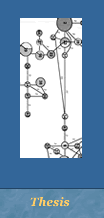Doctoral
Thesis
CONSERVATION
GENETICS IN PLANT SPECIES:
A
case study in the genus Limonium (Plumbaginaceae)



Was presented in Valencia
in December1997 in front of the following jury members:
Andrés
Moya Simarro
Vernor
Heywood
Marcelino
Pérez de la Vega
Josep
A. Roselló i Picornell
Julio
Rozas Uras
And
supervised by:
Fernando
González Candelas
"Clasification
makes organic diversity accesible to the other biological
disciplines. Without it, most of them would be unable to give
meaning to their findings."
Mayr
& Ashlock
"Todas
las plantas deberían de considerarse recursos fitogenéticos...Y
quienes trabajamos con plantas en peligro, es bueno que lo
hagamos con la conciencia de que nuestra actividad no es algo
romántico o quijotesco, sino que con ella está
directamente imbricado el futuro de la Humanidad".
César
Gómez Campo
SUMMARY
The main aim of my thesis was the study of natural populations
from an ecological and evolutionary point of view with a final
application to biodiversity management and its conservation. The
integration of ecology and evolutionary tools has allowed the
use of molecular markers for phylogenetics and population genetics
analyses of variability, which is essential for the conservation
of biodiversity. Some authorities in this matter now recognize
that most of the questions currently resolved in this context
could have not been answered without the use of molecular markers.
As model organism we chose the genus Limonium (sea lavander).
This genus is particularly interesting because it presents all
the main mechanisms of rapid speciation known in plants, i.e.
geographic and reproductive population isolation due to the patchy
distribution of the natural ecosystems its species inhabit as
well as the high frequency of hybridization and poliploidy, and
the possibility of reproduction through apomixis. These special
features and the close morphological relationship exhibited by
the species of this genus interfere enormously in its taxonomic
study specially when using morphological characters. On theoretical
grounds molecular analysis could bypass this drawback and offer
robust hypothesis on the evolution of Limonium species. Due to
the reticular evolution of the genus both organular and nuclear
molecular markers were employed for this purpose. First, I analyzed
RFLP in the chloroplast DNA using a genomic library that I developed
previously for Limonium narbonense. Secondly, I performed ITS
region sequence analysis of the nuclear rDNA cistron, which includes
the ITS1, the ITS2, and the 5.8 subunit, was performed. Most of
the Limonium species studied belong to section Limonium, this
is the section of the genus with the larger number of species
and the one in which most Mediterranean endemisms are classified.
Our conclusions from this study could only be discussed based
on the unique, morphological classification of the genus that
existed so far. We used several methods for the molecular data
analyses. All the phylogenies derived from both, the nuclear and
the chloroplast genomes are in disagreement with this previous
morphological classification. For instance, two species, L. narbonense
and L. vulgare, classified within section Limonium show levels
of divergence similar to species from other sections in which
the genus is subdivided. The rest of the species are monophyletic.
The low level of divergence among these later species with both
molecular data is consistent with a recent origin of this group.
The fragility of natural ecosystems where Limonium species inhabit
has lead to the nearly extinction of several endemisms, especially
those situated in the Mediterranean basin where tourism and agriculture
activities have damaged these habitats enormously. Two of the
most endangered species of the genus are L. dufourii and L. cavanillesii
(now known as L. perplexum) We analysed their intraspecific variability
and population genetic structure using two DNA fingerprinting
PCR based markers: AFLP and RAPDs.
Limonium cavanillesii is an extremely endangered species from
which only one natural population remains on our Mediterranean
coasts. It is triploid and apomictic. The analysis of genetic
variation using RAPDs revealed no polymorphic markers. As an additional
effort to find variability we used AFLP technique. Only 11, very
closely related, phenotypes were found. The low variability levels
in this species confirm that the population has suffered from
a recent and severe bottleneck. However, its distribution of pairwise
differences was typical of a population in equilibrium in the
past. Future management measures taken on the species should consider
the variability encountered, for instance for the establishment
of new self-sustained natural populations and in reintroduction
experiments.
Limonium dufourii is also triploid and apomictic. The remaining
six populations from this species are distributed along the Valencia
and Castellón provinces. Most of these populations are
at the verge of extinction. To establish the relationships among
the different AFLP and RAPD patterns, multivariate statistical
analyses and minimum spanning networks were employed. All of them
demonstrated that these relationships are not coincident with
the actual population subdivision. To explain this result, the
analysis of nucleon diversity allowed us to infer the historical
demographic pattern of each population and to establish a hypothesis
on the evolution of the species. Patterns of population genetic
structure determined from AMOVA and HOMOVA analyses were extremely
useful for the establishment of ex situ and in situ conservation
management measures necessary on each population.
MOLECULAR
TOOLS USED
Phylogenetic
studies:
-plasmidic
and phagic genomic libraries
-cpDNA
RFLP
-ITS
sequencing
Population
studies:
-RAPD
and AFLP
-microsatellites
DATA
ANALYSIS USED
Phylogenetic
reconstruction methods
-parsimony
analysis
-distance
analysis
Population
variability and structure methods
-minimum
spanning network and multivariant analysis
-nucleon
diversity analysis
-AMOVA
and HOMOVA analysis
PUBLICATIONS
RELATED
Carmen Palacios, Josep A. Rosselló & Fernando González-Candelas
A
comparative phylogenetic analysis of the genus Limonium (Plumbaginaceae)
using RFLP cpDNA and ITS sequencing.
Molecular
Phylogenetics and Evolution 14, 232-249 (2000)
Carmen Palacios & Fernando González-Candelas
Lack
of genetic Variability in the rare and endangered plant species
Limoniumcavanillesii using RAPD markers
Molecular
Ecology 6, 671-675 (1997)
Carmen Palacios & Fernando González-Candelas
AFLP
analysis of the critically endangered plant Limonium cavanillesii
and comparison with RAPD analysis
Journal
of Heredity 90(4), 485-489 (1999)
Carmen Palacios y Fernando González-Candelas
Analysis
of population genetic structure and variability in the endemic
and endangered plant species Limoniumdufourii (Plumbaginaceae)
Molecular
Ecology 6, 1107-1122 (1997)
CONCLUSIONS
The results obtained through the study of intra and interspecific
variability in the different Limonium species by using
empirical and conceptual tools from the Population Genetics and
Phylogenetics, has allowed us to draw several conclusions, not
only from micro and macroevolutionary patterns and processes of
these species, but also for the management of the populations
of the most endangered species in the Comunidad Valenciana, Limonium
cavanillesii and L. dufourii.
- It has been demonstrated the need of an adequate sampling strategy
to detect intraspecific variability in molecular phylogenetic
studies, especially when there is evidence of hybridization and/or
introgression, and cytoplasmic DNA or repetitive gene families
are used as markers.
- The different rDNA and cpDNA types detected in L. delicatulum,
L. interjectum and L. furfuraceum are paraphyletic,
with divergence levels similar to those of other species from
section Limonium. This result reinforces the introgression and/or
hybridization hypotheses for the origin of these species.
- In all phylogenies obtained L. narbonense and L. vulgare,
from subsection Genuinae, form a sister clade (monophyletic group)
to the rest of the species from section Limonium, with levels
of divergence similar or even higher than those of species from
other sections of the genus. Consequently, the actual placement
of L. narbonense and L. vulgare within section Limonium
is questioned.
- The remaining species from section Limonium always form a monophyletic
group in all the topologies resulting from phylogenetic analyses.
The low levels of divergence encountered at this level imply a
recent origin of these species. In general, there is a lack of
resolution within this clade that could be due to the reticular
evolution of these highly related species. This fact is confirmed
by the lack of concordance between cpDNA and ITS phylogenies.
- It has been demonstrated the usefulness of comparing the results
obtained from cytoplasmic and nuclear markers. Likewise, the use
of different methods of phylogenetic analysis has demonstrated
to be very helpful to interpret the results obtained and to extract
more reliable conclusions about the evolution of these genomes.
- Besides, in those species in which a more exhaustive analysis
of intraspecific variability has been performed, the use of appropriate
analytical methods to determine the intraspecific relationships
and the population structure has been essential to extract as
much information as possible from the molecular data, in spite
of the restrictions imposed by dominant markers. It is noteworthy
that dicotomic trees are very strict representations of the evolutionary
relationships among the phenotypes or populations studied. Other
type of representations, such as MSN (minimum spanning networks),
have demonstrated to be more adequate, as it is possible to extract
more information from the same data.
- The low levels of variability encountered in the species L.
cavanillesii could be due to its obligate apomictic reproductive
system. However, only one population with very low numbers has
been discovered in nature, which implies that it has passed through
a severe bottleneck, after which there has been no chance for
mutation to restore the levels of genetic variability expected
in a population that could have been in equilibrium in the past,
as pointed by the analysis of nucleon diversity.
- Conservation of this unique L. cavanillesii population
must be an urgent measure, as its low genetic variability makes
it very sensible to environmental changes. The best strategy might
be the protection of the area where it is currently established,
declared as a small reserve, and the re-establishment of new self-sustaining
populations in suitable habitats. Micropropagation of a representative
sample of the variability encountered would be the most appropriate
ex situ conservation measure. Finally, we believe that
L. cavanillesii should be catalogued as critically endangered
according to the IUCN categories of threat.
- The study of intraspecific variability in the species L.
dufourii has demonstrated that there are two divergent phenotype
groups (A and B) within Marjal del Moro populations. Moreover,
phenotypes that belong to other populations present a higher similarity
to those from group B, which points to a common origin of these
phenotypes and its posterior dispersion, colonizing suitable habitats
north and southwards. But divergence levels among phenotypes from
groups A and B are within those expected for intraspecific studies.
- The high level of population structuring within L. dufourii
makes it advisable to prevent transplantation of individuals or
seeds from one population to another, with the possible exception
of El Saler population, with only 7 individuals, in which reintroduction
of new variability from group B individuals of Marjal del Moro
populations is recommendable. In situ measures of conservation
for the different populations should be complemented by ex
situ measures, which must take into account the diversity
and population subdivision encountered in the species. L. dufourii
should be catalogued as endangered according to the IUCN categories
of threat.
- Comparative results of detectable variability levels with different
molecular markers, as AFLPs and RAPDs, can not be generalized
even for evolutively close species. However, when PCR based DNA
fingerprinting methods are the best choice in a particular study,
AFLP method represents the most advantageous technique, if the
necessary equipment and the economic resources are available.

















